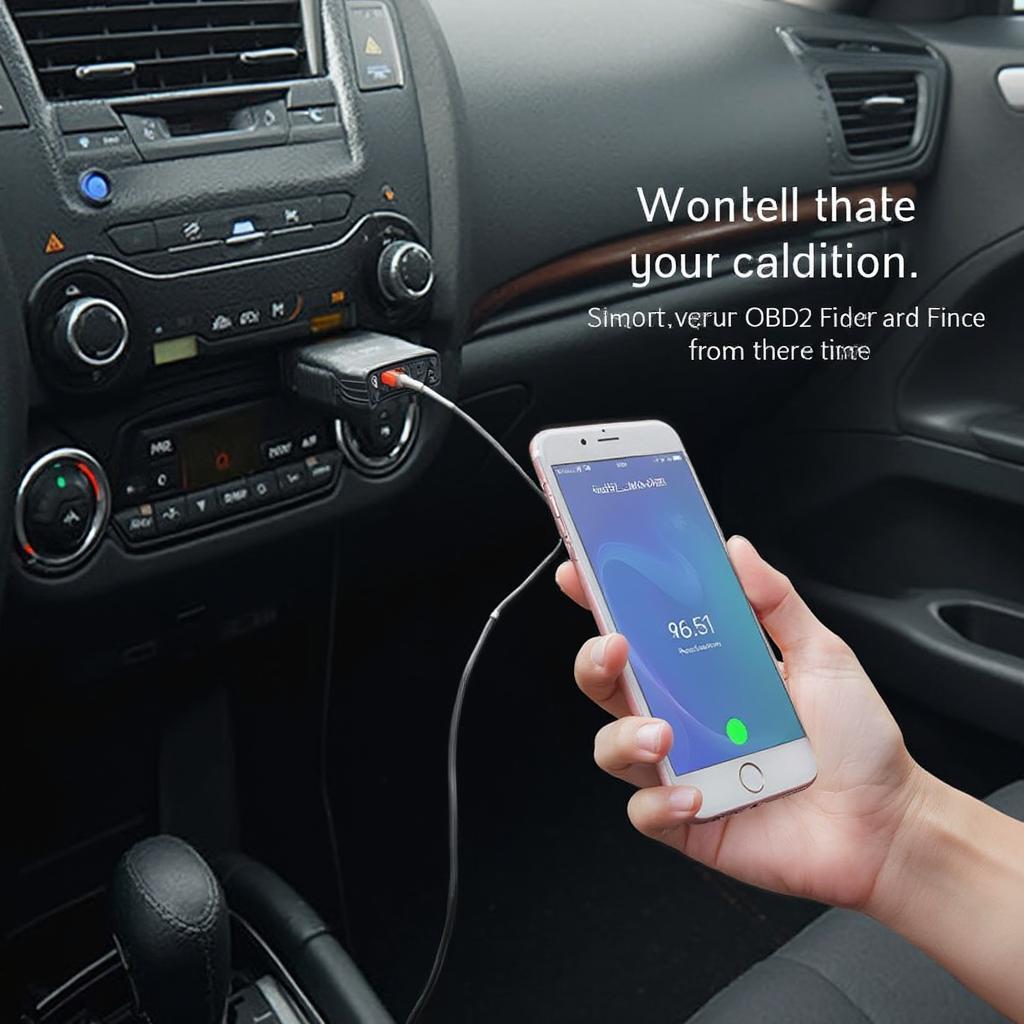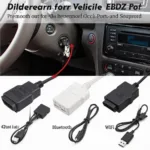Smartphone OBD2 readers are revolutionizing how we interact with our vehicles. These compact devices, paired with a user-friendly app, transform your smartphone into a powerful diagnostic tool, putting control and knowledge right at your fingertips. Whether you’re a car enthusiast, a DIY mechanic, or just want to keep a closer eye on your vehicle’s health, understanding the capabilities of smartphone OBD2 readers is essential.
Understanding the Basics of Smartphone OBD2 Readers
Smartphone OBD2 readers connect to your car’s OBD2 port, typically located under the dashboard on the driver’s side. They communicate with your phone via Bluetooth or Wi-Fi, transmitting real-time data from your vehicle’s computer. This data allows you to monitor everything from engine performance and fuel efficiency to emissions and sensor readings. Essentially, these small devices give you a window into your car’s inner workings, empowering you to identify potential issues before they become major problems.
Why Choose a Smartphone OBD2 Reader?
Convenience and affordability are key factors driving the popularity of smartphone OBD2 readers. Compared to traditional standalone scanners, they are significantly cheaper and more portable. Imagine having a mechanic in your pocket, ready to diagnose a check engine light at a moment’s notice, without the cost of a trip to the repair shop. That’s the power a smartphone OBD2 reader puts in your hands.
 Smartphone OBD2 reader plugged into a car's OBD2 port
Smartphone OBD2 reader plugged into a car's OBD2 port
Key Features and Benefits of Smartphone OBD2 Readers
Beyond simple diagnostics, smartphone OBD2 readers offer a wealth of features that enhance your driving experience. They can track your driving habits, monitor fuel consumption, and even provide real-time performance data. Some advanced models even offer features like smog check readiness, trip logging, and GPS tracking.
Diagnosing Trouble Codes with Your Smartphone
One of the primary functions of a smartphone obd2 reader is to read and interpret diagnostic trouble codes (DTCs). These codes, commonly known as “check engine light” codes, indicate specific issues within your vehicle’s systems. With a smartphone OBD2 reader and a compatible app, you can quickly identify the source of the problem, saving you time and money on unnecessary repairs.
Enhancing Your Driving Experience with Real-Time Data
Smartphone OBD2 readers go beyond simple diagnostics. They empower you to monitor real-time data like speed, RPM, coolant temperature, and fuel economy. This data can be invaluable for optimizing your driving habits and improving fuel efficiency. For car enthusiasts, it offers a deeper understanding of their vehicle’s performance characteristics.
“For the everyday driver, a smartphone OBD2 reader can be a game-changer. It’s like having a personal mechanic on call, 24/7,” says John Smith, Automotive Engineer at Car Diagnostics Inc.
Choosing the Right Smartphone OBD2 Reader
With a wide range of smartphone obd2 readers available, choosing the right one can seem daunting. Consider factors like compatibility with your vehicle and smartphone, the features offered, and the user-friendliness of the accompanying app. Reading reviews and comparing different models can help you make an informed decision.
Compatibility and App Functionality
Ensure the reader you choose is compatible with both your vehicle’s OBD2 protocol and your smartphone’s operating system (iOS or Android). The app is crucial; look for one that’s intuitive, easy to navigate, and provides clear, concise data presentation.
“Investing in a quality smartphone OBD2 reader is a small price to pay for the peace of mind it provides,” adds Jane Doe, Senior Mechanic at Auto Repair Solutions. “It’s a powerful tool for any car owner.”
Conclusion
Smartphone OBD2 readers are invaluable tools for anyone who owns a car. They offer a convenient, affordable, and powerful way to diagnose problems, monitor vehicle health, and enhance your overall driving experience. By understanding the features and benefits of these devices, you can empower yourself to take control of your car’s maintenance and stay informed about its performance. Choosing the right smartphone obd2 reader can save you money, time, and potential headaches down the road.
FAQ
- Are smartphone OBD2 readers compatible with all cars? Most cars manufactured after 1996 are compatible with OBD2 readers.
- Do I need a special app to use a smartphone OBD2 reader? Yes, you will need a compatible app to connect to the reader and interpret the data.
- Can I use a smartphone OBD2 reader to clear trouble codes? Yes, most readers and apps allow you to clear diagnostic trouble codes.
- How much do smartphone OBD2 readers cost? Prices vary, but they are generally much more affordable than traditional standalone scanners.
- Are there any security concerns with using a smartphone OBD2 reader? Ensure you choose a reputable brand and app to minimize any potential security risks.
- Can a smartphone OBD2 reader improve my car’s fuel efficiency? By monitoring real-time data and adjusting your driving habits, you can potentially improve fuel economy.
- What other data can a smartphone OBD2 reader provide? Many readers offer access to a wide range of data, including speed, RPM, coolant temperature, and more.
Common Scenarios and Questions
- Scenario: Check Engine Light comes on. Question: What’s wrong with my car?
- Scenario: Car feels sluggish. Question: Is there a performance issue?
- Scenario: Want to monitor fuel consumption. Question: How can I track my mileage and fuel usage?
Related Articles and Resources
- Understanding OBD2 Codes
- Choosing the Right OBD2 App
- Troubleshooting Common Car Problems
Need assistance? Contact us via WhatsApp: +1(641)206-8880, Email: [email protected] or visit our office at 789 Elm Street, San Francisco, CA 94102, USA. We offer 24/7 customer support.

